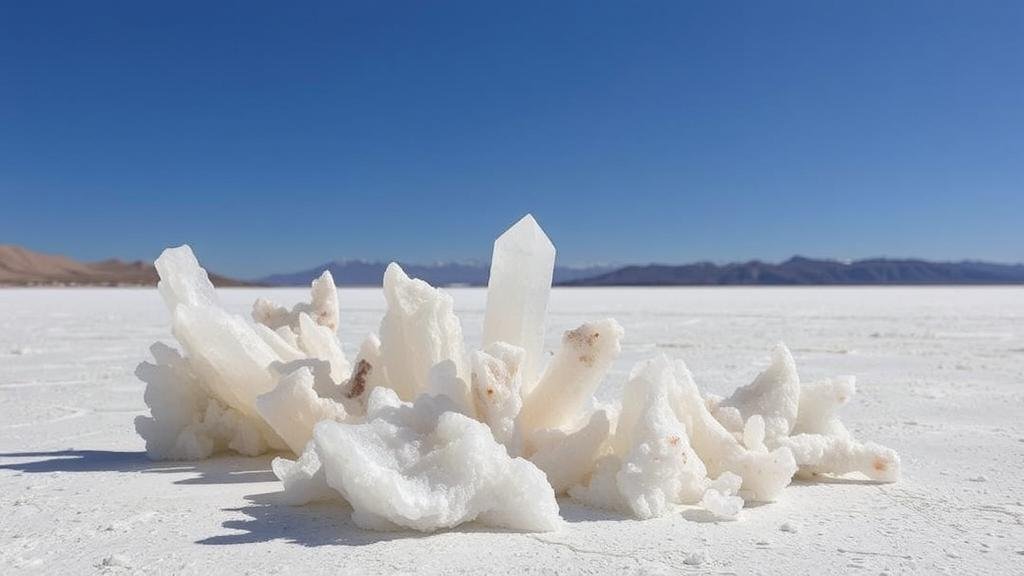Selenite Treasures: Discovering Crystal Formations in Desert Salt Flats
Selenite Treasures: Discovering Crystal Formations in Desert Salt Flats
For rockhounds and mineral collectors, the allure of exploring desert salt flats is not just the vast landscapes; it’s the hidden treasures like selenite waiting to be discovered. Selenite, a crystalline form of gypsum, is prized for its unique properties and stunning beauty. This article delves into the characteristics of selenite, its formation, locations where collectors can find it, and tips on how to effectively gather this stunning mineral.
Understanding Selenite
Selenite is a transparent to translucent variety of gypsum that crystallizes in the monoclinic system. It is composed of calcium sulfate dihydrate (CaSO₄·2H₂O) and typically forms as evaporite deposits in hot, dry environments. The name selenite derives from the Greek word for moon, Selene, owing to the mineral’s ethereal glow.
One of the most fascinating properties of selenite is its ability to form in various shapes, including tabular, striated, and lamellar crystals. It’s also notable for its perfect cleavage, which allows it to be easily split into thin sheets. Typically, selenite can display colors ranging from pure white to shades of yellow, brown, and even pink, depending on the impurities present. The mineral also has a low hardness rating of 2 on the Mohs scale, making it relatively soft compared to other crystals.
Where to Find Selenite
Desert salt flats are among the best locations to hunt for selenite formations, particularly in regions known for historical evaporative conditions. Here are notable sites:
- Badwater Basin, Death Valley, California: This area is below sea level and is rich in evaporite minerals. It’s famous for its expansive salt flats where selenite crystals can be found.
- Gypsum Dunes, White Sands National Park, New Mexico: This park contains large deposits of gypsum, and selenite crystals can often be found at the surface of the dunes.
- Selenite Mines, Alabaster Caverns State Park, Oklahoma: Timing your visit to coincide with the warmer months can reward collectors with higher exposure of selenite in its natural environment.
The Formation of Selenite
Selenite forms in dry, arid environments where conditions favor the evaporation of water. The process begins with the evaporation of seawater or saline lake water, leading to the concentration of minerals. As water evaporates, calcium and sulfate ions remain, gradually crystallizing into selenite formations. typical environment for these formations includes areas with gypsum-rich sedimentary rocks.
To provide perspective on the scale of these formations, selenite crystals can often grow to impressive sizes; some from the Naica mine in Chihuahua, Mexico, have measured over 12 meters long. These colossal selenite crystals provide insight into the prolonged environmental conditions required for crystal growth.
Collecting Selenite: Tips and Best Practices
For rockhounds eager to collect selenite, preparation and caution are paramount. Here are practical tips to ensure a successful outing:
- Use Appropriate Tools: A small rock hammer, chisels, and safety goggles are essential for safely extracting specimens without damaging them.
- Check Local Regulations: Always understand and follow collecting laws in your chosen area. Some locations may require permits or have restrictions on the amount of material that can be collected.
- Handle with Care: Due to selenites softness, handle your specimens gently to avoid scratches or breaks. Use protective packaging when transporting your finds.
- Stay Hydrated and Safe: Deserts can be extreme environments. Bring ample water and sunscreen to stay safe while you explore.
Conclusion: The Joy of Collecting Selenite
Exploring desert salt flats for selenite can be one of the most rewarding experiences for rockhounds and collectors. unique beauty and diverse formations of selenite not only add aesthetic value to collections but also provide fascinating insights into geological processes. With proper preparation and an understanding of the mineral’s properties, enthusiasts can embark on a fruitful adventure, uncovering these translucent treasures beneath the sun-soaked landscapes.
In summary, whether you are an experienced collector or a novice rockhound, the search for selenite crystal formations in desert salt flats can be both educational and exhilarating. By following the outlined tips and understanding where to look, you can enhance your collecting experience and appreciation for these remarkable minerals.



